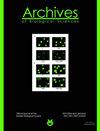拉脱维亚(Rāzna湖)作为欧洲种群的一部分的多态雷塞纳种群的遗传特征
IF 0.8
4区 生物学
Q4 BIOLOGY
引用次数: 0
摘要
斑马贻贝(Dreissena polymorpha)广泛分布于欧洲。斑马贻贝的扩张对湖泊或河流的原生生物群产生了负面影响。对种群遗传结构的研究可以确定拉脱维亚这种入侵物种的现状,作为欧洲种群的一部分。尽管微卫星在群体遗传学研究中的重要性日益增加,但拉脱维亚缺乏关于多形菌的此类数据。利用雷尔兹纳湖6个微卫星位点DpolA6、Dpo260、Dpo272、Dpo101、Dpo221和Dpo04对斑马贻贝的遗传结构进行了研究。微卫星位点多态性高,等位基因数量多。等位基因多样性较高,每个位点有4 ~ 20个等位基因。平均观察杂合度为0.58,平均期望杂合度为0.70。高度的遗传多样性使物种能够适应不断变化的环境。本文章由计算机程序翻译,如有差异,请以英文原文为准。
Genetic characteristics of the Dreissena polymorpha population in Latvia (Lake Rāzna) as part of the European population
The zebra mussel Dreissena polymorpha is widely distributed in Europe. The expansion of zebra mussels has a negative impact on the native biota of lakes or rivers. Studies of the genetic structure of populations allow the identification of the current state of this invasive species in Latvia as a part of the European population. Despite the increasing importance of microsatellites in studies of population genetics, there is a lack of such data on D. polymorpha in Latvia. The present study investigates the genetic population structure of zebra mussels using six microsatellite loci as follows: DpolA6, Dpo260, Dpo272, Dpo101, Dpo221 and Dpo04 from Lake R?zna. The microsatellite loci in the investigated population have a high polymorphism and number of alleles. Allelic diversity at all described loci was high, ranging from 4 to 20 alleles per locus. The mean observed heterozygosity was 0.58 and the mean expected heterozygosity was 0.70. A high genetic diversity enables species to adapt to changing environments.
求助全文
通过发布文献求助,成功后即可免费获取论文全文。
去求助
来源期刊
CiteScore
1.40
自引率
0.00%
发文量
25
审稿时长
3-8 weeks
期刊介绍:
The Archives of Biological Sciences is a multidisciplinary journal that covers original research in a wide range of subjects in life science, including biology, ecology, human biology and biomedical research.
The Archives of Biological Sciences features articles in genetics, botany and zoology (including higher and lower terrestrial and aquatic plants and animals, prokaryote biology, algology, mycology, entomology, etc.); biological systematics; evolution; biochemistry, molecular and cell biology, including all aspects of normal cell functioning, from embryonic to differentiated tissues and in different pathological states; physiology, including chronobiology, thermal biology, cryobiology; radiobiology; neurobiology; immunology, including human immunology; human biology, including the biological basis of specific human pathologies and disease management.

 求助内容:
求助内容: 应助结果提醒方式:
应助结果提醒方式:


